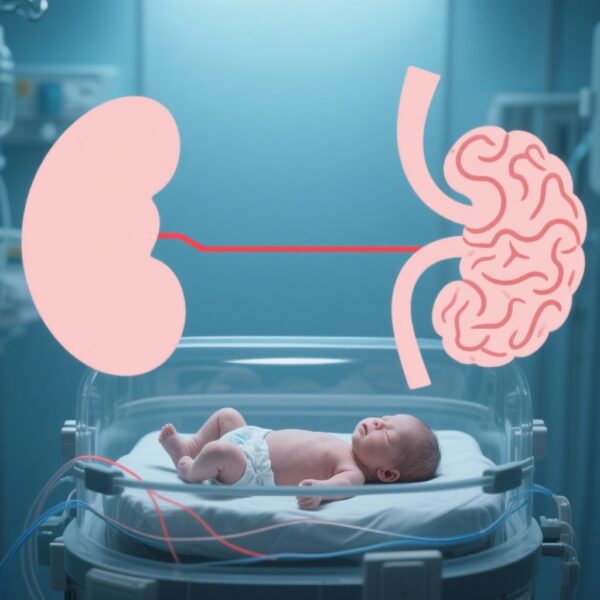Highlights
Patients with unruptured brain arteriovenous malformations (AVMs) who underwent interventional treatment had higher 5‑year hemorrhage‑free survival (96.2%) than those managed conservatively (89.0%), with an absolute risk difference of 7.23% and hazard ratio 0.44.
Longer follow‑up (10 years) showed a sustained benefit (risk difference 8.37%; HR 0.56). Benefits were concentrated in low‑grade, compact nidus AVMs; no clear benefit was seen for high‑grade or diffuse nidus lesions.
Sensitivity analyses indicated microsurgical resection was the only modality consistently associated with reduced hemorrhage risk; radiosurgery and embolization effects were less consistent.
The study used a target‑trial emulation (clone‑censor‑weight and inverse‑probability weighting) applied to a prospective nationwide registry to mitigate biases where an RCT is infeasible.
Background and clinical context
Brain arteriovenous malformations (AVMs) are congenital tangles of abnormal arteries and veins that create a direct arteriovenous shunt without an intervening capillary bed. The natural history of an unruptured AVM includes a low, but non‑negligible annual hemorrhage risk that accumulates over a patient’s lifetime. Management options are heterogeneous: conservative observation, microsurgical resection, stereotactic radiosurgery (SRS), endovascular embolization (often adjunctive), or combinations. Treatment decisions must weigh short‑term procedure‑related morbidity and mortality against the long‑term risk of spontaneous hemorrhage.
The ARUBA randomized trial (short follow‑up) suggested initial conservative management because treated patients experienced more early morbidity. Since then, clinicians and guideline panels have debated whether select patients—particularly those with low surgical risk and life expectancy—might benefit from definitive treatment over the long term. Randomized trials with long follow‑up are challenging for ethical, logistical, and feasibility reasons, prompting the use of advanced observational methods that attempt to emulate the target randomized trial.
Study design and methods
This analysis used data from the Multimodality Treatment for Brain Arteriovenous Malformation in Mainland China (MATCH) registry, a nationwide, multicenter prospective collaboration (August 1, 2011–December 31, 2021). The investigators applied a target‑trial emulation framework to observational registry data to compare outcomes of interventional treatment versus conservative management among patients with unruptured AVMs at baseline. Key features:
Population
1770 patients with unruptured AVMs at baseline. Median age was 26.2 years (IQR 16.5–37.6); 59.8% were male. The registry captured a broad contemporary cohort across multiple centers in mainland China.
Interventions and comparator
Interventional treatment defined as microsurgical resection, stereotactic radiosurgery, endovascular embolization, or combinations, initiated within 6 months of diagnosis. Conservative management included observation and medical therapy.
Outcomes and analytic strategy
Primary outcome: 5‑year hemorrhage‑free survival (survival without AVM‑related hemorrhage or death). Secondary outcome: 10‑year hemorrhage‑free survival. To approximate the randomization process and control for time‑varying confounding and immortal time bias, the authors used a clone‑censor‑weight approach with inverse probability of censoring–weighted survival analyses. Hazard ratios and absolute risk differences with 95% confidence intervals were estimated. Predefined subgroup analyses included Spetzler‑Martin grade and nidus morphology (compact vs diffuse).
Key findings
Primary and secondary outcomes
At 5 years, the estimated hemorrhage‑free survival was 96.23% (95% CI, 93.95%–97.65%) in the interventional group versus 89.00% (95% CI, 86.37%–91.24%) in the conservative group. The absolute risk difference was 7.23% (95% CI, 4.78%–9.91%) favoring intervention. The hazard ratio for hemorrhage (intervention versus conservative) was 0.44 (95% CI, 0.33–0.57), indicating a 56% relative reduction in the hazard of hemorrhage or death over the 5‑year period.
At 10 years, the benefit persisted: risk difference 8.37% (95% CI, 2.68%–15.70%); HR 0.56 (95% CI, 0.42–0.69).
Subgroup and modality‑specific findings
The benefit of interventional therapy was not uniform. Patients with high‑grade AVMs or diffuse nidus morphology did not show clear benefit from intervention compared with conservative care; outcomes were similar between strategies in these subgroups. In sensitivity analyses examining specific modalities, only microsurgical resection consistently associated with reduced hemorrhage risk. Radiosurgery and endovascular embolization, alone or in some combinations, did not consistently reduce long‑term hemorrhage compared with conservative management.
Safety and procedural considerations
The primary reported outcome was hemorrhage‑free survival (a composite that included death). Detailed reporting of early procedural morbidity, functional outcomes (e.g., modified Rankin Scale), and quality of life was not the focus of the main result synopsis; these elements are crucial for interpreting net clinical benefit because interventions can produce short‑term neurological deficits that may offset long‑term hemorrhage reductions—an issue previously emphasized by ARUBA.
Interpretation and expert commentary
This large, well‑conducted registry analysis provides important evidence that, when using modern causal inference techniques to emulate a target randomized trial, interventional treatment for select patients with unruptured AVMs is associated with improved hemorrhage‑free survival at 5 and 10 years compared with conservative management. The magnitude of absolute benefit (≈7–8% at 5–10 years) is clinically meaningful, particularly in younger patients whose lifetime hemorrhage risk is greater.
However, several caveats temper broad generalization:
– Residual confounding: Despite sophisticated methods (clone‑censoring, inverse‑probability weighting), unmeasured confounders—such as subtle angiographic features, patient preference, surgeon experience, and center volume—may influence both treatment choice and outcomes.
– Treatment heterogeneity: “Interventional treatment” grouped several modalities with different risk‑benefit profiles. The finding that microsurgery drove the observed benefit suggests that outcomes depend heavily on careful patient selection for the modality most likely to achieve complete obliteration with acceptable operative risk.
– Outcome definition: The composite endpoint of AVM‑related hemorrhage or death, while pragmatic, might mix competing risks. Non‑AVM‑related deaths or procedure‑related neurologic morbidity are important for clinical decisions and should be reported alongside hemorrhage rates and functional outcomes.
– Generalizability: The MATCH registry reflects practice patterns, resource availability, and patient demographics within mainland China. Applicability to other healthcare settings should be considered cautiously.
– Comparison with prior randomized evidence: The ARUBA trial raised concern about early harms of intervention, leading many clinicians to favor conservative management for unruptured AVMs. This new evidence suggests the balance may shift over longer follow‑up and in selected lesions, particularly compact, low‑grade AVMs amenable to surgical resection.
Taken together, the data support a nuanced, individualized approach: low‑grade, compact AVMs in younger patients with acceptable surgical risk may derive net long‑term benefit from definitive treatment (often microsurgery), whereas diffuse or high‑grade lesions may remain better managed conservatively or with palliative strategies.
Clinical implications and recommendations
– Individualized decision‑making: Management should integrate patient age, AVM angioarchitecture (nidus compactness, deep venous drainage, eloquence, size), Spetzler‑Martin grade, comorbidity, life expectancy, and patient values.
– Modality selection: For low‑grade, surgically accessible AVMs, microsurgical resection—when performed in experienced centers—appears to offer the clearest hemorrhage risk reduction. Radiosurgery and embolization should be considered based on lesion size, location, and the probability of achieving obliteration without unacceptable morbidity.
– Shared decision making: Discuss short‑term procedural risks and potential for early neurological deficits versus longer‑term reductions in hemorrhage risk. Decision aids that incorporate individualized risk estimates would be valuable.
– Systems and expertise: Outcomes are operator‑ and center‑dependent; referral to multidisciplinary high‑volume centers is advisable for complex cases.
Limitations and future research
This analysis represents an important observational contribution but does not replace randomized evidence. Future work should prioritize:
– Detailed reporting of functional outcomes and health‑related quality of life to assess net clinical benefit.
– Multinational pooled registries and collaborative studies to enhance generalizability and statistical power for subgroup analyses.
– Cost‑effectiveness analyses and decision modeling that incorporate age, lesion characteristics, and probabilities of obliteration and complications for each modality.
– Continued methodological development in target‑trial emulation and causal inference applied to contemporary neurosurgical registries.
Conclusion
In a large nationwide cohort using target‑trial emulation, interventional treatment of unruptured AVMs—particularly microsurgical resection in carefully selected patients—was associated with improved hemorrhage‑free survival at 5 and 10 years compared with conservative management. These findings support individualized, multidisciplinary decision‑making and underscore the value of advanced observational methods to inform clinical practice when randomized trials are impractical. Clinicians should weigh procedure‑related risks and functional outcomes alongside long‑term hemorrhage prevention when counseling patients.
Funding and trial registration
Multimodality Treatment for Brain Arteriovenous Malformation in Mainland China (MATCH) Registry. Details on funding sources were reported in the original publication.
References
Han H, Chen Y, Ma L, et al; Multimodality Treatment for Brain Arteriovenous Malformation in Mainland China (MATCH) Registry. Interventional Treatment vs Conservative Management of Unruptured Brain Arteriovenous Malformations. JAMA Netw Open. 2025 Nov 3;8(11):e2543408. doi:10.1001/jamanetworkopen.2025.43408.
(Additional foundational trials and guideline citations such as ARUBA and major consensus statements are relevant for context and should be consulted directly when forming treatment recommendations.)



